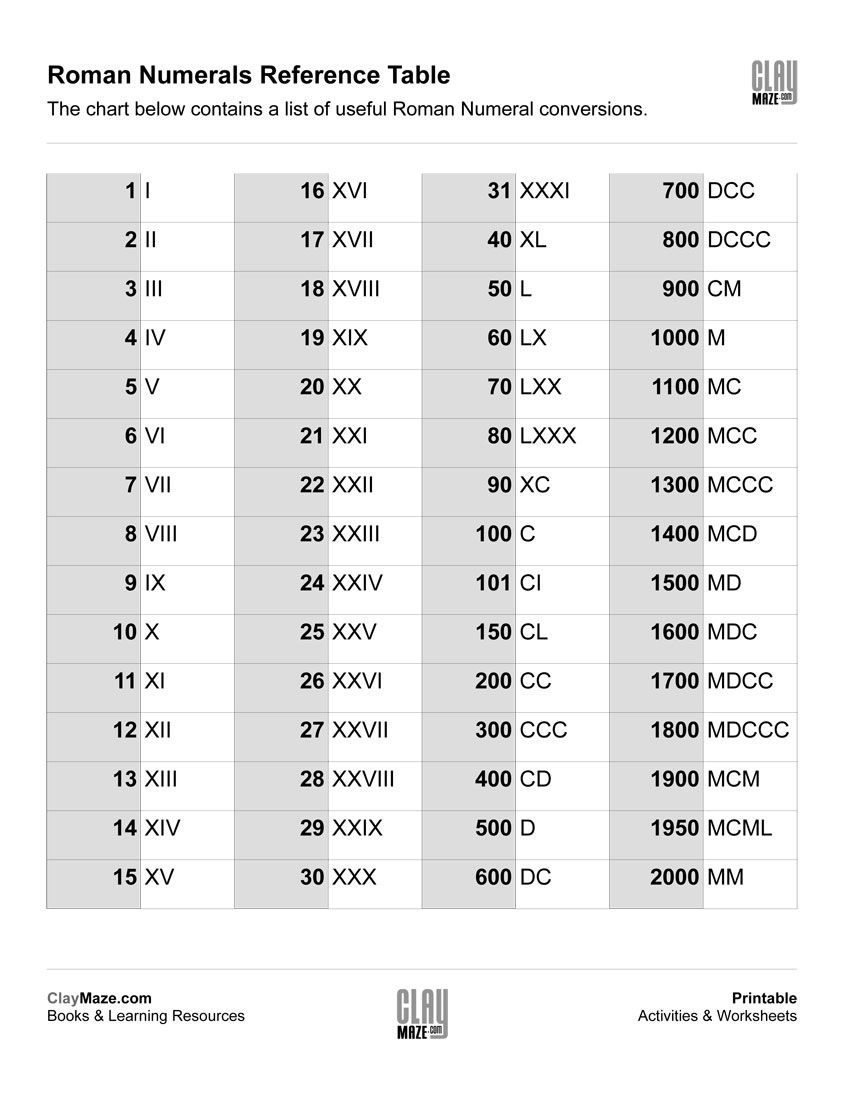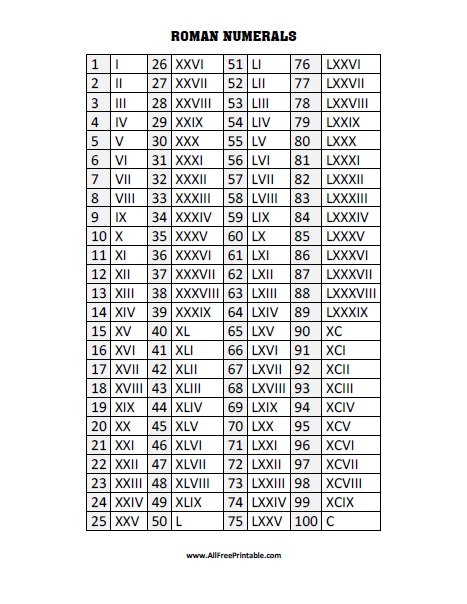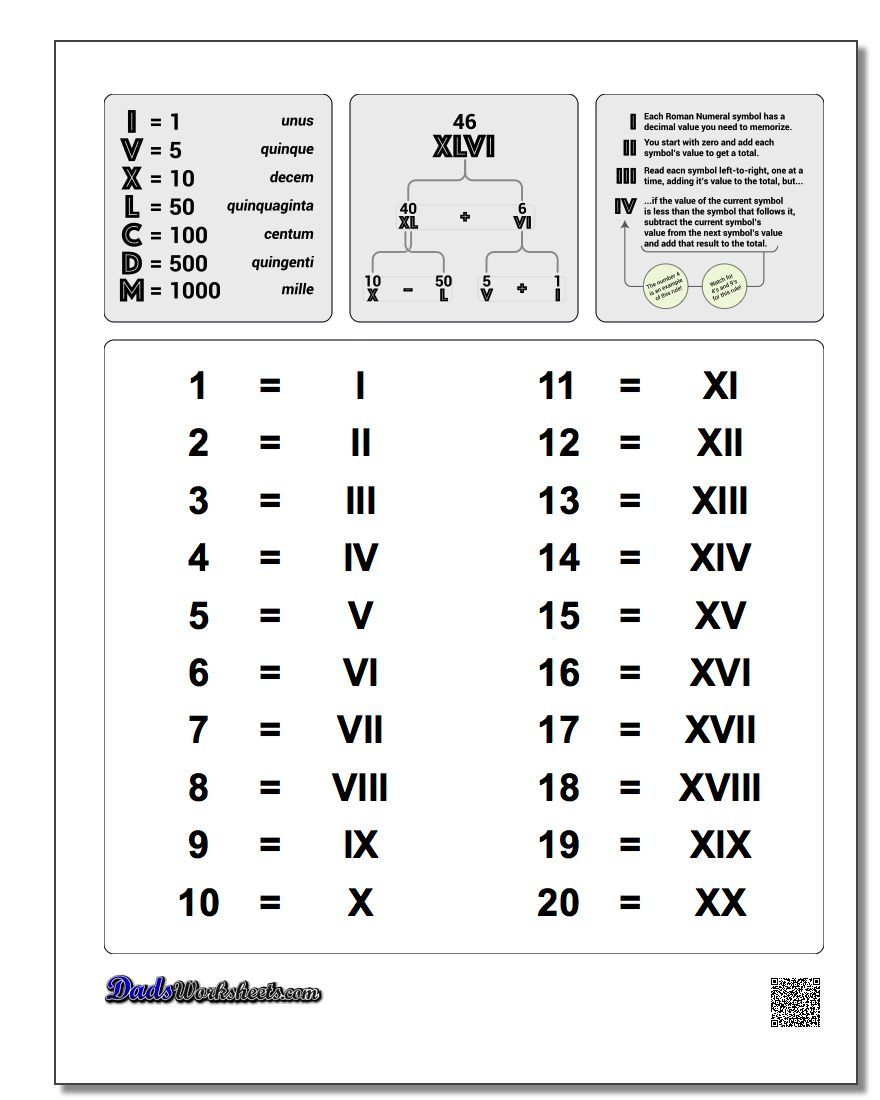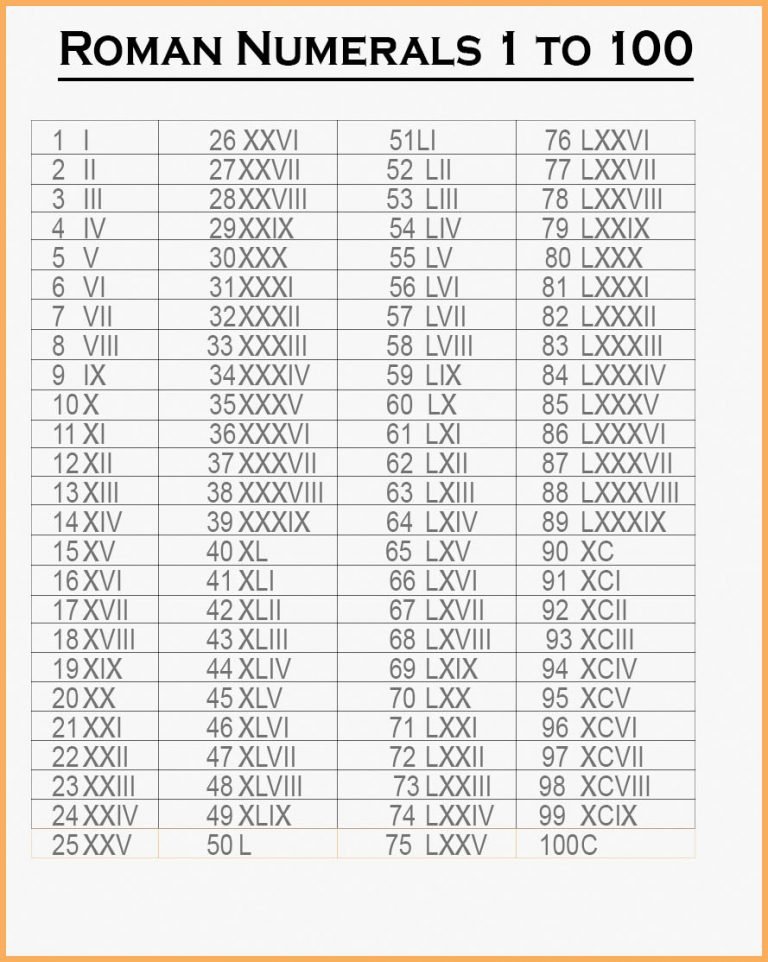Roman numerals have a rich history and are still used in various contexts today. They are a numerical system that originated in ancient Rome and were commonly used until the 14th century. Despite the development of modern numeral systems, Roman numerals continue to intrigue and captivate people around the world.
Exploring a Roman Numerals Chart
 Let’s start by taking a look at a Roman Numerals Chart 1-100. This chart provides a comprehensive list of Roman numerals from 1 to 100. It’s a handy reference tool when you’re trying to decipher Roman numerals or convert them to their corresponding Arabic (standard) numbers. Roman numerals consist of seven basic symbols: I, V, X, L, C, D, and M, representing the numbers 1, 5, 10, 50, 100, 500, and 1000, respectively. By combining these symbols, different numbers can be formed.
Let’s start by taking a look at a Roman Numerals Chart 1-100. This chart provides a comprehensive list of Roman numerals from 1 to 100. It’s a handy reference tool when you’re trying to decipher Roman numerals or convert them to their corresponding Arabic (standard) numbers. Roman numerals consist of seven basic symbols: I, V, X, L, C, D, and M, representing the numbers 1, 5, 10, 50, 100, 500, and 1000, respectively. By combining these symbols, different numbers can be formed.
Understanding the Roman Numerals System
 The Roman numerals system is based on the concept of adding and subtracting values. When a smaller value appears in front of a larger value, it is subtracted. For example, IV represents 4 (5 - 1) and IX represents 9 (10 - 1). Conversely, when a smaller value appears after a larger value, it is added. For instance, VI represents 6 (5 + 1) and XI represents 11 (10 + 1).
The Roman numerals system is based on the concept of adding and subtracting values. When a smaller value appears in front of a larger value, it is subtracted. For example, IV represents 4 (5 - 1) and IX represents 9 (10 - 1). Conversely, when a smaller value appears after a larger value, it is added. For instance, VI represents 6 (5 + 1) and XI represents 11 (10 + 1).
Roman numerals are often used in various contexts, such as indicating the year on monuments and buildings, numbering chapters or pages in books, and denoting the order of royalty (e.g., Henry VIII). They also make appearances in tattoos, providing a visually appealing and unique way to represent important numbers or dates. Many people choose to get Roman numeral tattoos to commemorate special events in their lives, such as birthdays, anniversaries, or the birth of a child.
A Valuable Reference Tool
 When trying to decipher Roman numerals, having a reference chart like the Roman Numbers 1-100 Chart will prove incredibly useful. It provides a quick and easy way to translate Roman numerals into their corresponding Arabic numbers and vice versa. Whether you’re solving math problems, engaging in historical research, or simply satisfying your curiosity, this chart will be your trusty companion.
When trying to decipher Roman numerals, having a reference chart like the Roman Numbers 1-100 Chart will prove incredibly useful. It provides a quick and easy way to translate Roman numerals into their corresponding Arabic numbers and vice versa. Whether you’re solving math problems, engaging in historical research, or simply satisfying your curiosity, this chart will be your trusty companion.
Another helpful tool is the Free Printable Roman Numerals Chart. It offers a concise reference for Roman numerals, allowing you to quickly locate the symbol for a specific number. Its simplicity and clarity make it a great resource for students learning about ancient civilizations, curious minds, or anyone who encounters Roman numerals in their daily lives.
Converting Roman Numerals to Standard Numbers
 Converting Roman numerals to standard numbers can be a challenging task, especially for larger numbers. The Free Printable Roman Numerals Chart \/Roman Number Chart simplifies this process by providing a comprehensive list of Roman numerals up to 1000. With this chart, you can easily decipher complex Roman numerals and understand their corresponding Arabic numbers.
Converting Roman numerals to standard numbers can be a challenging task, especially for larger numbers. The Free Printable Roman Numerals Chart \/Roman Number Chart simplifies this process by providing a comprehensive list of Roman numerals up to 1000. With this chart, you can easily decipher complex Roman numerals and understand their corresponding Arabic numbers.
Further Exploration
If you’re interested in exploring Roman numerals beyond the basic charts, there are many resources available. The Free Printable Roman Numerals 1 to 1000 Charts provide an even broader range of Roman numerals to explore and analyze. These charts are ideal for those looking to delve deeper into the world of Roman numerals or engage in more complex numeral conversions.
Roman numerals continue to fascinate and intrigue people across the globe. Their unique symbols and ancient origins make them a captivating subject of study and exploration. Whether you’re solving a crossword puzzle, deciphering a historical inscription, or contemplating a meaningful tattoo, the world of Roman numerals is waiting to be discovered.
 This Roman Numerals Chart serves as a valuable resource, allowing you to quickly find the Roman numeral equivalents for numbers up to 100. Its clear and concise design makes it easy to navigate and understand, making it a must-have reference tool for anyone encountering Roman numerals.
This Roman Numerals Chart serves as a valuable resource, allowing you to quickly find the Roman numeral equivalents for numbers up to 100. Its clear and concise design makes it easy to navigate and understand, making it a must-have reference tool for anyone encountering Roman numerals.
Converting Roman Numerals Up To M to Standard Numbers
 The process of converting Roman numerals to standard numbers becomes increasingly complex as the numbers get larger. However, the Converting Roman Numerals Up To M To Standard Numbers (A) printable offers a helpful resource for tackling this challenge. It provides step-by-step instructions and examples for converting Roman numerals up to M (1000). With this printable, you’ll be able to decipher even the most intricate Roman numeral combinations.
The process of converting Roman numerals to standard numbers becomes increasingly complex as the numbers get larger. However, the Converting Roman Numerals Up To M To Standard Numbers (A) printable offers a helpful resource for tackling this challenge. It provides step-by-step instructions and examples for converting Roman numerals up to M (1000). With this printable, you’ll be able to decipher even the most intricate Roman numeral combinations.
Expanding the Understanding
 For a more comprehensive exploration of Roman numerals, the Free Printable Roman Numerals 1-100 Chart Template should be your go-to resource. It offers a detailed breakdown of Roman numerals up to 100, providing a deeper understanding of their intricate patterns and structures. By studying this chart, you’ll gain a solid foundation in Roman numerals and unlock their secrets.
For a more comprehensive exploration of Roman numerals, the Free Printable Roman Numerals 1-100 Chart Template should be your go-to resource. It offers a detailed breakdown of Roman numerals up to 100, providing a deeper understanding of their intricate patterns and structures. By studying this chart, you’ll gain a solid foundation in Roman numerals and unlock their secrets.
Additionally, if you’re ready to tackle the even more complex world of Roman numerals, the Roman Numerals 1- 1000 chart is an ideal tool. This expansive chart provides a comprehensive overview of Roman numerals up to 1000, offering countless opportunities for exploration and discovery.
In conclusion, Roman numerals have a fascinating history and continue to be relevant in various contexts today. They are a unique numerical system that adds intrigue and sophistication to any setting. Whether you’re studying ancient civilizations, solving puzzles, or considering a Roman numeral tattoo, the resources provided here offer valuable tools and insights. Embrace the beauty and complexity of Roman numerals and embark on a journey through time and numbers.